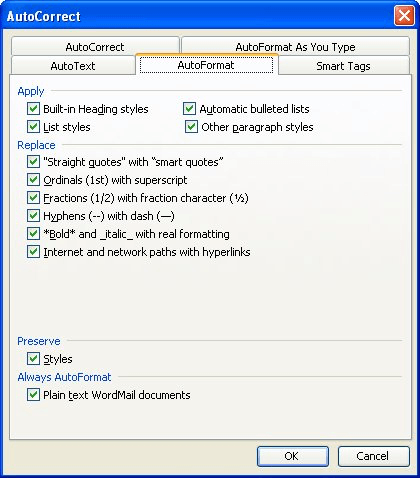Please Note: This article is written for users of the following Microsoft Word versions: 97, 2000, 2002, and 2003. If you are using a later version (Word 2007 or later), this tip may not work for you. For a version of this tip written specifically for later versions of Word, click here: Changing AutoFormatting Rules.
Written by Allen Wyatt (last updated November 16, 2019)
This tip applies to Word 97, 2000, 2002, and 2003
There are two types of AutoFormatting that can be done with Word. The first, AutoFormat As You Type, is done (you guessed it) while you type. The second, plain old AutoFormat, is done when you call the feature into action, as described in the previous tip.
Word allows you to control the type of actions taken by AutoFormat when processing a document. If you want to change the way AutoFormat works, there are two ways you can do so. First, you can choose AutoCorrect (or AutoCorrect Options) from the Tools menu. Word then displays the AutoCorrect dialog box, where you should make sure the AutoFormat tab is selected. The second way is to choose AutoFormat from the Format menu. In the resulting AutoFormat dialog box, click on Options. (See Figure 1.)

Figure 1. The AutoFormat tab of the AutoCorrect dialog box.
Regardless of the method you use to access the options, Word displays a list of formatting actions that can be applied by AutoFormat. Each action has a check box associated with it; if you select a check box, the associated action is performed. Clear the check box to prohibit AutoFormat from taking an action.
WordTips is your source for cost-effective Microsoft Word training. (Microsoft Word is the most popular word processing software in the world.) This tip (639) applies to Microsoft Word 97, 2000, 2002, and 2003. You can find a version of this tip for the ribbon interface of Word (Word 2007 and later) here: Changing AutoFormatting Rules.

Learning Made Easy! Quickly teach yourself how to format, publish, and share your content using Word 2021 or Microsoft 365. With Step by Step, you set the pace, building and practicing the skills you need, just when you need them! Check out Microsoft Word Step by Step today!
Word can understand many different measurement units. One common unit understood by Word is the pica, described in this tip.
Discover MoreSmart quotes can be helpful in making a great-looking document, but at times they can be a real pain. Wouldn't it be ...
Discover MoreNeed to get rid of the formatting applied to a bunch of text? One of the easiest ways to do this is to use Notepad in ...
Discover MoreFREE SERVICE: Get tips like this every week in WordTips, a free productivity newsletter. Enter your address and click "Subscribe."
There are currently no comments for this tip. (Be the first to leave your comment—just use the simple form above!)
Got a version of Word that uses the menu interface (Word 97, Word 2000, Word 2002, or Word 2003)? This site is for you! If you use a later version of Word, visit our WordTips site focusing on the ribbon interface.
Visit the WordTips channel on YouTube
FREE SERVICE: Get tips like this every week in WordTips, a free productivity newsletter. Enter your address and click "Subscribe."
Copyright © 2025 Sharon Parq Associates, Inc.
Comments